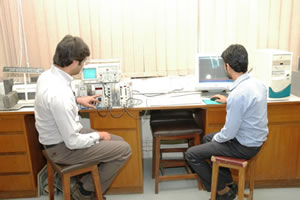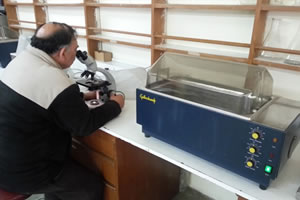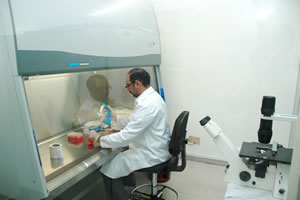Department of Physics & Applied Mathematics
Labs and Facilities
Radiation Detection Laboratory
 This lab serves as the main hub for radiation facilities in the department and PIEAS. The basic mandate of the lab includes training students in safely handling small scale laboratory radiation sources and operation of nuclear electronics. Various types of detectors are available for Alpha, Beta and Gamma spectroscopy/counting. These include HPG, Surface Barrier Detectors, Na(I), Geiger Counters and BF3 detectors to name a few. A variety of radiation source of various types and strengths are also available for use.
This lab serves as the main hub for radiation facilities in the department and PIEAS. The basic mandate of the lab includes training students in safely handling small scale laboratory radiation sources and operation of nuclear electronics. Various types of detectors are available for Alpha, Beta and Gamma spectroscopy/counting. These include HPG, Surface Barrier Detectors, Na(I), Geiger Counters and BF3 detectors to name a few. A variety of radiation source of various types and strengths are also available for use.
Student's carryout basic radiation experiments in this lab to a name a few such as
1. |
Measurement of mixed half-lives |
2. |
Measurement of attenuation coefficient using Na(I) |
3. |
Gamma Gamma coincidence |
4. |
Na(I) spectroscopy |
5. |
Characteristics of GM tube |
6. |
Counting Statistics |
The lab also provides repair of electronic components of the detection chain. MS students also carry out Research projects in the lab as well.
Laser Laboratory
 This lab serves as the main hub for radiation facilities in the department and PIEAS. The basic mandate of the lab includes training students in safely handling small scale laboratory radiation sources and operation of nuclear electronics. Various types of detectors are available for Alpha, Beta and Gamma spectroscopy/counting. These include HPG, Surface Barrier Detectors, Na(I), Geiger Counters and BF3 detectors to name a few. A variety of radiation source of various types and strengths are also available for use. This lab serves as the main hub for radiation facilities in the department and PIEAS. The basic mandate of the lab includes training students in safely handling small scale laboratory radiation sources and operation of nuclear electronics. Various types of detectors are available for Alpha, Beta and Gamma spectroscopy/counting. These include HPG, Surface Barrier Detectors, Na(I), Geiger Counters and BF3 detectors to name a few. A variety of radiation source of various types and strengths are also available for use.
This lab serves as the main hub for radiation facilities in the department and PIEAS. The basic mandate of the lab includes training students in safely handling small scale laboratory radiation sources and operation of nuclear electronics. Various types of detectors are available for Alpha, Beta and Gamma spectroscopy/counting. These include HPG, Surface Barrier Detectors, Na(I), Geiger Counters and BF3 detectors to name a few. A variety of radiation source of various types and strengths are also available for use. This lab serves as the main hub for radiation facilities in the department and PIEAS. The basic mandate of the lab includes training students in safely handling small scale laboratory radiation sources and operation of nuclear electronics. Various types of detectors are available for Alpha, Beta and Gamma spectroscopy/counting. These include HPG, Surface Barrier Detectors, Na(I), Geiger Counters and BF3 detectors to name a few. A variety of radiation source of various types and strengths are also available for use.
Biophotanics Laboratory
 This lab serves as the main hub for radiation facilities in the department and PIEAS. The basic mandate of the lab includes training students in safely handling small scale laboratory radiation sources and operation of nuclear electronics. Various types of detectors are available for Alpha, Beta and Gamma spectroscopy/counting. These include HPG, Surface Barrier Detectors, Na(I), Geiger Counters and BF3 detectors to name a few. A variety of radiation source of various types and strengths are also available for use. This lab serves as the main hub for radiation facilities in the department and PIEAS. The basic mandate of the lab includes training students in safely handling small scale laboratory radiation sources and operation of nuclear electronics. Various types of detectors are available for Alpha, Beta and Gamma spectroscopy/counting. These include HPG, Surface Barrier Detectors, Na(I), Geiger Counters and BF3 detectors to name a few. A variety of radiation source of various types and strengths are also available for use.
This lab serves as the main hub for radiation facilities in the department and PIEAS. The basic mandate of the lab includes training students in safely handling small scale laboratory radiation sources and operation of nuclear electronics. Various types of detectors are available for Alpha, Beta and Gamma spectroscopy/counting. These include HPG, Surface Barrier Detectors, Na(I), Geiger Counters and BF3 detectors to name a few. A variety of radiation source of various types and strengths are also available for use. This lab serves as the main hub for radiation facilities in the department and PIEAS. The basic mandate of the lab includes training students in safely handling small scale laboratory radiation sources and operation of nuclear electronics. Various types of detectors are available for Alpha, Beta and Gamma spectroscopy/counting. These include HPG, Surface Barrier Detectors, Na(I), Geiger Counters and BF3 detectors to name a few. A variety of radiation source of various types and strengths are also available for use.
Femtosecond Laboratory
 This lab serves as the main hub for radiation facilities in the department and PIEAS. The basic mandate of the lab includes training students in safely handling small scale laboratory radiation sources and operation of nuclear electronics. Various types of detectors are available for Alpha, Beta and Gamma spectroscopy/counting. These include HPG, Surface Barrier Detectors, Na(I), Geiger Counters and BF3 detectors to name a few. A variety of radiation source of various types and strengths are also available for use. This lab serves as the main hub for radiation facilities in the department and PIEAS. The basic mandate of the lab includes training students in safely handling small scale laboratory radiation sources and operation of nuclear electronics. Various types of detectors are available for Alpha, Beta and Gamma spectroscopy/counting. These include HPG, Surface Barrier Detectors, Na(I), Geiger Counters and BF3 detectors to name a few. A variety of radiation source of various types and strengths are also available for use.
This lab serves as the main hub for radiation facilities in the department and PIEAS. The basic mandate of the lab includes training students in safely handling small scale laboratory radiation sources and operation of nuclear electronics. Various types of detectors are available for Alpha, Beta and Gamma spectroscopy/counting. These include HPG, Surface Barrier Detectors, Na(I), Geiger Counters and BF3 detectors to name a few. A variety of radiation source of various types and strengths are also available for use. This lab serves as the main hub for radiation facilities in the department and PIEAS. The basic mandate of the lab includes training students in safely handling small scale laboratory radiation sources and operation of nuclear electronics. Various types of detectors are available for Alpha, Beta and Gamma spectroscopy/counting. These include HPG, Surface Barrier Detectors, Na(I), Geiger Counters and BF3 detectors to name a few. A variety of radiation source of various types and strengths are also available for use.
Solid State Nuclear Track Detection (SSNTD) Laboratory
 Situated in A-block, SSNTD (also called dosimetry) laboratory is one of the oldest labs in PIEAS, built in 1989. This lab is dedicated to the detection of charged particles and fission fragments using the track etching techniques. The detectors available through this lab are CR-39, LR-115, CN-85. After exposure the detectors are etched in Gallenkamp etching bath using an appropriate basic solution such as NaOH. The tracks can then be visualized under an optical microscope.
Situated in A-block, SSNTD (also called dosimetry) laboratory is one of the oldest labs in PIEAS, built in 1989. This lab is dedicated to the detection of charged particles and fission fragments using the track etching techniques. The detectors available through this lab are CR-39, LR-115, CN-85. After exposure the detectors are etched in Gallenkamp etching bath using an appropriate basic solution such as NaOH. The tracks can then be visualized under an optical microscope.
CR-39 detectors, in this lab, have been used extensively for radon surveys in Pakistan using the NRPB radon dosimeters.
Radiation Transport Facility Laboratory
 This lab serves as the main hub for radiation facilities in the department and PIEAS. The basic mandate of the lab includes training students in safely handling small scale laboratory radiation sources and operation of nuclear electronics. Various types of detectors are available for Alpha, Beta and Gamma spectroscopy/counting. These include HPG, Surface Barrier Detectors, Na(I), Geiger Counters and BF3 detectors to name a few. A variety of radiation source of various types and strengths are also available for use. This lab serves as the main hub for radiation facilities in the department and PIEAS. The basic mandate of the lab includes training students in safely handling small scale laboratory radiation sources and operation of nuclear electronics. Various types of detectors are available for Alpha, Beta and Gamma spectroscopy/counting. These include HPG, Surface Barrier Detectors, Na(I), Geiger Counters and BF3 detectors to name a few. A variety of radiation source of various types and strengths are also available for use.
This lab serves as the main hub for radiation facilities in the department and PIEAS. The basic mandate of the lab includes training students in safely handling small scale laboratory radiation sources and operation of nuclear electronics. Various types of detectors are available for Alpha, Beta and Gamma spectroscopy/counting. These include HPG, Surface Barrier Detectors, Na(I), Geiger Counters and BF3 detectors to name a few. A variety of radiation source of various types and strengths are also available for use. This lab serves as the main hub for radiation facilities in the department and PIEAS. The basic mandate of the lab includes training students in safely handling small scale laboratory radiation sources and operation of nuclear electronics. Various types of detectors are available for Alpha, Beta and Gamma spectroscopy/counting. These include HPG, Surface Barrier Detectors, Na(I), Geiger Counters and BF3 detectors to name a few. A variety of radiation source of various types and strengths are also available for use.
Medical Physics Laboratory

Medical Physics is a branch of science that deals with harnessing the use of radiation for the benefit of the humans. The benefit could be the treatment of cancer or visualizing it by means of imaging techniques. In each of these cases a controlled delivery and monitoring of radiation is necessary. This requires the use of specialized instruments and techniques.
Followed by the initiation of a Master's program in Medical Physics at PIEAS (2001) a lab was also developed in 2004 with the assistance provided by the International Atomic Energy Agency under a Technical Co-operation Project PAK/6/017. This facility at PIEAS provides a research base for the MS/PhD thesis projects.
Photo Medicine Research Laboratory (PMRL)
 Photo Medicine Research Laboratory (PMRL) is functioning in Department of Physics and Applied Mathematics for in vivo and in vitro studies of cancerous and non cancerous cells both for diagnostic and therapeutic purposes.
Photo Medicine Research Laboratory (PMRL) is functioning in Department of Physics and Applied Mathematics for in vivo and in vitro studies of cancerous and non cancerous cells both for diagnostic and therapeutic purposes.
It has the basic cell culturing facility comprising of biosafty cabinet class-II, type A2 for cell culturing and Co2 incubator for maintaining the culture. For image purposes two inverted microscopes (Ttrinocular) with CCD camera are installed. For drug optical spectroscopy UV-VIS spectrophotometer is available. For data collection micro plate reader with different wavelengths has been also installed in the laboratory. Light delivery source "630 nm diode laser" suitable for drug activation is also in access to researchers / students. For sterilization of different cell cultures autoclave 40 L is available. Cell culture related kits are stored on regular basis in Freezer -20 0C and ultra low freezer (Tem Range: -40 0C to -90 0C) as per requirement.
Last Updated: 08 April 2014


